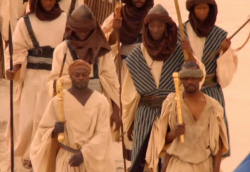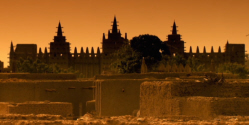Mansa Musa Gold - Mali Africa
The old core of the Islamic Empire had been destroyed by Genghis Khan. But the decimation of Christian Europe by the Black Death meant that the stand-off between these two great religions would go on.
Yet trade between them always continued, too, especially between Venice and the fabulously wealthy Muslim city of Cairo. And in July 1324, something appeared on the horizon that would have a startling effect on Cairo’s economy. A train of up to 60,000 soldiers, 70 camels, and 500 slaves carrying sceptres of gold.

Leading this astonishing procession was an African king, Mansa Musa, on a pilgrimage to Islam’s holy city, Mecca. They had spent a year marching more than 2,000 miles across the vast desert that separated most of Africa from the Mediterranean world.
Mansa Musa was king of the greatest of the African empires south of the Sahara. Mali was a Muslim society where lots of people could read and write. It was a rich land based on farmers and fishermen, and on trading towns like Timbuktu and Djenne on the River Niger.
The Niger was a lifeline of Mansa Musa’s vast empire… Carrying goods throughout his kingdom which occupied nearly half a million square miles. But the most significant source of Mansa Musa’s prosperity was a commodity craved by rulers all over the world… Gold.
Mali was an African El Dorado, the most of the world knew nothing about it. Until now. When Mansa Musa’s glittering caravan stopped off at Cairo, on its way to Mecca, he was an immediate sensation. He and his entourage spent three months in the city as guests of the Egyptian ruler, freely handing out gold to its astonished residents. Cairo at the time was the world’s largest gold market. But he threw around so much of the stuff that the price of gold plummeted. Indeed, merely because of Mansa Musa’s tips, the economy of Cairo, it is said, took ten years to recover.
The sudden appearance of Mansa Musa and his gold was a revelation. The world had just got bigger and richer. By the end of the 14th century, two-thirds of the gold in Europe came from Mali.

It’s thanks to the Muslim trading world that Mali was able to touch hands with Europe. And it’s thanks to the Muslim travellers and writers we know so much about it. But Mali was not alone. There were plenty of other African civilisations at this time. There was Zimbabwe, with its great storm-city dwellers. There was Benin, with its amazing metalworkers, who could rival anything in Italy or Germany at the time.
But it was gold and glittering Mali that had caught the European imagination. And in 1375, when map-makers in Spain produced a series of charts, known as the Catalan Atlas, Mansa Musa was shown sitting at the centre of Mali.
Mansa Musa had quite literally put Africa on the European map.
